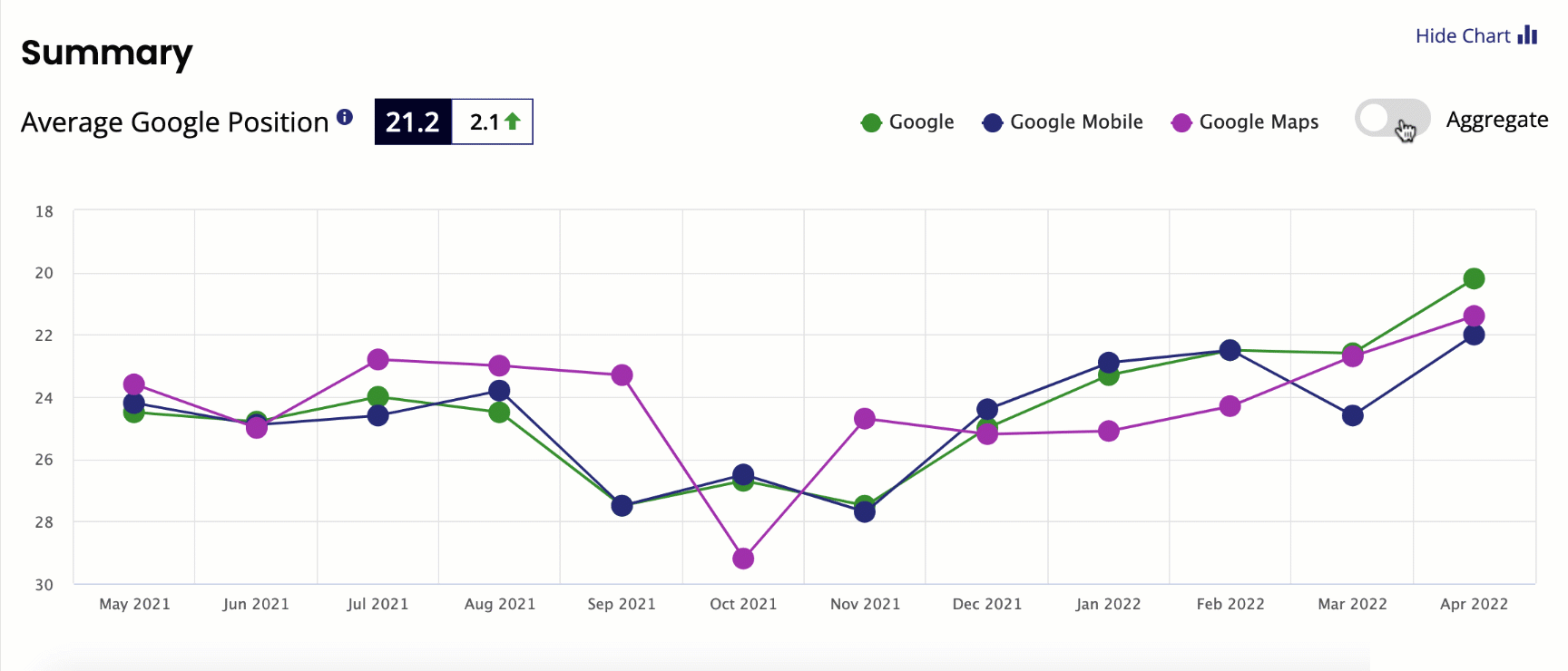It’s a big day here at Brightlocal! We have three new updates to Local Search Rank Checker.
1. Local Search Rank Checker is now called Local Rank Tracker
It’s probably best we tackle this one first so it’s easier for you to follow this launch post! Local Search Rank Checker is a name we chose over 10 years ago, and since then we’ve outgrown it. ‘Checker’ suggests it checks rankings once, or on an ad hoc basis, but that’s not how our customers use it. They use it to track rankings over time so they can measure the impact of their local SEO efforts. This new name makes it easier to understand what the product does and the value it brings. This name change is reflected in the BrightLocal platform, on our website, and in our supporting content. So if you’re looking for guides in the Help Center, you’ll now find these listed under Local Rank Tracker. Now that’s out of the way, we can get to the good stuff.
2. Introducing Average Google Position
We’ve added a brand new metric into ‘Local Rank Tracker’ called ‘Average Google Position’–a single metric to understand ranking performance at a glance. As the name suggests, it measures the average position of all your ranking keywords across Google organic results (on both desktop and mobile) and Google local results. 
Find out more: Learn how we calculate Average Google Position
We know that local marketers are short on time, and measuring ranking performance often means looking at different data points. Average Google Position makes this process quick and simple.
Bringing greater context to ranking movement
If you’re monitoring rankings on a weekly or monthly basis without Average Google Position, you likely measure how many keywords moved up or down. But that often removes vital context. For example, if your report showed that four keywords increased but eight decreased, you might conclude that there’s been a drop in search visibility. But what if those five keywords jumped up between 10-15 positions, while the keywords that decreased only lost 1 or 2 places? Then that’s a whole different story. Average Google Position indicates whether ranking fluctuations are actually resulting in more or less search visibility.
Easily compare search visibility across desktop, mobile and map results
Because local search covers more than just the classic “blue links” in Google, you need a way to easily understand what’s behind changes to your Average Google Position. On top of aggregating all your ranking data, we also allow you to segment it based on desktop, mobile and map results. So if there was a recent local algorithm update, you can easily measure the impact by looking at your Average Google Position in Google Maps. 
We don’t see Average Google Position as a replacement for all other ranking metrics. Understanding local ranking performance requires more than a single metric. But we do believe it will reduce the time it takes to understand the impact of your SEO efforts and help you identify when it’s time to dive deeper into your ranking data.
We also see it as a useful metric for communicating progress with clients. However, we also realize it might not be something that you want to include in your client reporting right away. So if you don’t want to share it with clients, you can hide it from your external reports with a single click.

3. Faster, more accurate ranking data
The final update to Local Rank Tracker might be under the hood, but it’s no less important. Let’s set the scene: Local Rank Tracker runs over 320,000 reports every month. Those reports contain a total of 3.8 million keywords. In most cases, these keywords are tracked across five search engines. Throw competitor tracking into the mix and that’s a lot of ranking data to process every single month. We work hard to ensure our rank processing systems are several steps ahead of our growth, but every once and a while we need to take a bigger leap forward. We’ve done with this most recent improvement to our rank processing. This isn’t just to match our growth—we’ve done this to give you faster and more accurate ranking reports now. On top of turbo-boosting rank processing, we’ve improved systems that help us maintain ongoing data accuracy. Google has a knack of changing the markup on their SERPs, which can sometimes impede our ability to pull data accurately. While we always react promptly to rectify the curveballs Google throws at us, we felt we needed a more robust way of detecting changes and alerting the necessary teams. This improvement has also gone live and is already significantly reducing the chances of inaccurate data from making its way into Local Rank Tracker reports. That’s all for now, but we’ll be back soon to tell you about more updates and improvements to the BrightLocal platform. For now, head over to your Local Rank Tracker reports to discover your Average Google Position. And please let us know what you think in the comments.
